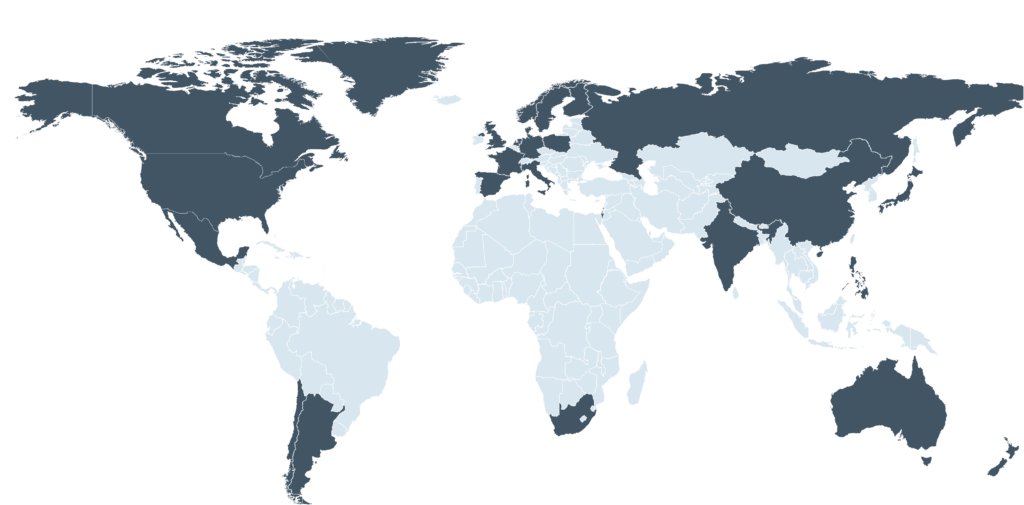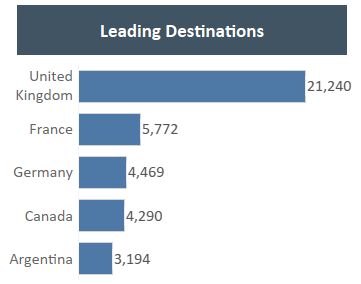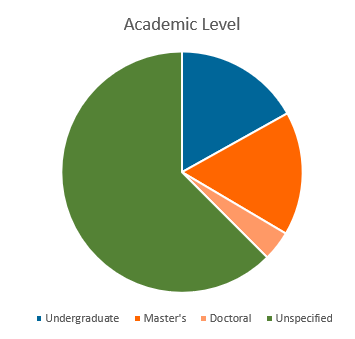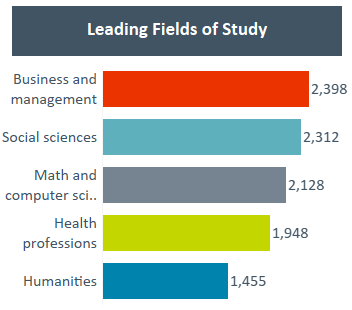BLOG: Project Atlas reports more than 50,000 U.S. students pursued a degree abroad in 2019/20
Leah Mason

Earlier this year, IIE launched a new webpage to feature data on U.S. students pursuing full degrees abroad, highlighting where U.S. students enroll, at what academic level, and in which fields of study. IIE’s Project Atlas initiative invites partner organizations to share data on international student mobility worldwide, including information on U.S. students who enroll in full degree programs abroad.
Check out a summary of our Project Atlas 2021 findings:
In 2021, 17 Project Atlas partners reported 50,933 U.S. students enrolled in full degree programs abroad.
Leading Destinations
Anglophone countries are a popular choice among students, with 60 percent of U.S. students enrolled in a full degree program in Australia, Canada, New Zealand, or the United Kingdom. Traditionally the most popular host for U.S. students studying abroad on short-term exchange programs for academic credit, the United Kingdom is also the dominant destination for U.S. students pursuing a full degree abroad, reporting more than 21,000 students in the 2019/20 academic year. Other leading host countries include France, Germany, Canada, and Argentina.

Academic Level
U.S. students enrolled in degree programs abroad at all academic levels. Of the 19,113 students whose academic level was reported by Project Atlas partners, 45 percent enrolled at the undergraduate level, 44 percent at the master’s level, and 11 percent at the doctoral level. In locations where universities have invested in English-medium instruction for advanced degree programs, such as Germany, Poland, Sweden, and Spain, a greater proportion of U.S. students are enrolled at the master’s and doctoral levels.1 In contrast, most U.S. students enrolled at institutions in Argentina are studying at the undergraduate level.

Field of Study
U.S. students enrolled in a range of fields of study. Leading fields of study include business and management, social sciences, math and computer sciences, health professions, and the humanities.2 However, the fields of study students enrolled in varied greatly by destination. For example, in Argentina, more than half of the U.S. students pursued a degree in fields categorized as math and computer sciences. In contrast, in Australia, more than one-third of U.S. students pursued a degree in the health professions, and in Spain more than one-third of U.S. students enrolled in business and management degree programs.

Why do U.S. students pursue a degree abroad?
Reasons U.S. students decide to enroll in degree programs at an institution outside of the United States include lower tuition costs, reduced time to earn a degree, and a desire to build intercultural competency and multilingual skills necessary to be competitive in a global workforce (Belyavina & Bhandari, 2012; Dickler, 2019). In addition, these students may also develop a new level of independence, exposure to various instructional methods, and an expanded network which together help them to stand out to employers after graduation (Wood, 2022).
And as long as U.S. students continue to pursue degrees abroad, IIE’s Project Atlas initiative will continue to collect data on their activities.
Looking for more information on U.S. study abroad trends?
IIE is your one-stop-shop for building a comprehensive picture of U.S. study abroad. To explore our interactive site and download an excel data file check out the U.S. students pursuing a full degree Project Atlas webpage. IIE’s Open Doors Report on International Educational Exchange, also shares data annually on U.S. students studying abroad through a U.S. higher education institution (either for academic credit or on a non-credit experience).
———————————————————
1Project Atlas partners in 13 countries reported data on students by academic level.
2Project Atlas partners in 9 countries reported data on students by field of study.